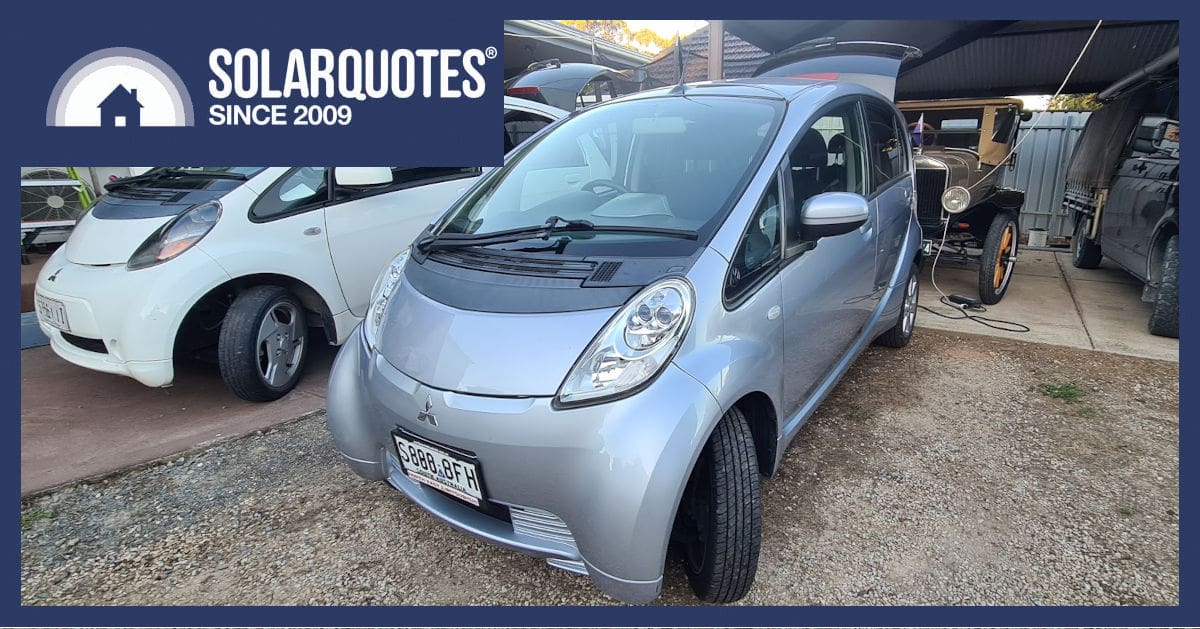
I can’t quite believe it’s been over a year since I penned an article about buying my first EV.
Despite my Mitsubishi i-MiEV being the cheapest in the country at the time, dropping $17,000 on an 11-year-old car was a little impulsive. However, with just 25,000km on the clock, it was about the newest car I’d ever owned. And so cute I’ve even named her: Irene.
At the time, my original article broke a couple of SolarQuotes website records, or so I’m told, with more than 40,000 people following along for the ride. I guess that proves two things, Australians are cheap; and just as interested in electric cars as I am. Since then, sales records for new EVs have continued to tumble.
So anyway I have a confession to make. I’ve bought yet another i-MiEV and my wife is already suspicious about the cover-story that my 203cm-tall dentist owns it.
For those asking why anyone would need two EVs that will reliably make 75km on a single charge… Well, for only $4,000, how could I not?
There’s more details below, but first, I’ve been meaning to write a follow-up on Irene, so here’s a few notes on my 6000+ kilometres travelled by kei car.
What’s Great About Owning An EV?
EVs Get You From A To B
The thing is, these little cars do exactly what most people need. Irene is a shopping trolley that sails through roundabouts, slips through gaps into turning lanes, and parks anywhere easily. According to the kids, the school run is a riot.
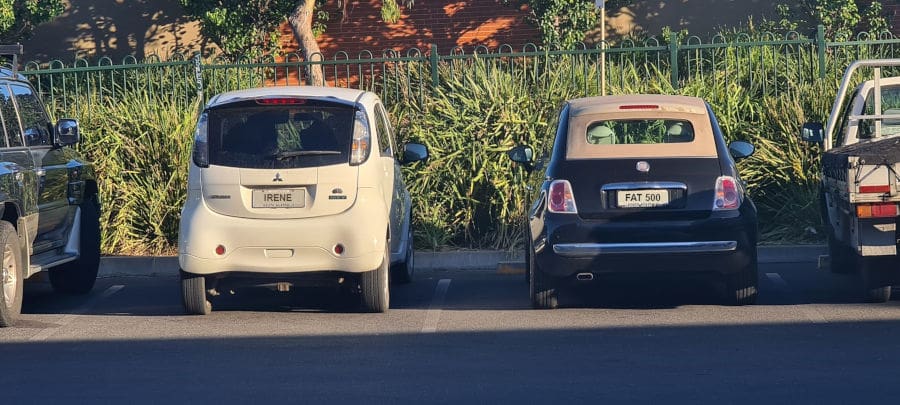
The Fiat 500 is pretty obese compared to it’s 1960s roots, but it’s still easy to park
At my local primary school, all the odious oil burners crawl up the access lane, stop for the zebra crossing, turn 180° (many can’t even manage that without backing & filling) then form a stuttering queue back to the road.
I stop near the entry/exit, because Irene is so small I can make a U-turn from the parallel parking bay and head straight back out.
Teachers and parents are so concerned about air quality at the school gate that they’re mandating people not sit in their cars with the engine idling. Want to keep your aircon running? With an EV it’s no issue.
The average new car in Europe has grown half a centimetre wider every year since 2001.
— Quite Interesting (@qikipedia) February 9, 2024
Supremely Low-Cost Motoring
For the first 1,340 kilometres, 196.3kWh and 19-or-so charging sessions, I kept a very careful record of how much energy Irene sipped.
I’m not quite dull enough to have kept that up for an entire year, but I think my mileage figures are relatively bad because I’m using air conditioning and doing highway speeds at times. I’ll have to check it again.
Even so, my consumption at 14.64kWh per 100km, using $0.45/kWh for peak-rate electricity. That’s $6.50/100km.
If we value solar electricity from my roof at $0.08 per kWh, the cost of motoring plunges to $1.17/100km.
Many people don’t readily comprehend fuel economy unless you’re speaking in miles-per-gallon. So to put it another way, $6.50 would buy 3.25 litres of diesel, enough to drive my VW Transporter 27km, maybe.
At $2 per litre for diesel, $1.17 will get me a little over an imperial pint. Or, 4.8km, which won’t even get me to the pub (where liquid fuels are five times more expensive).
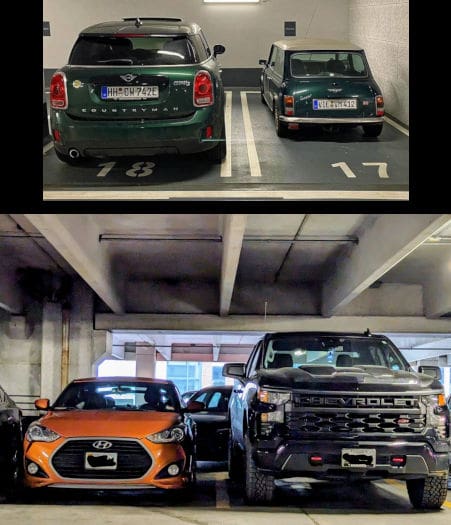
I still miss my Mini, but the driver in that Chev would never have even seen it.
What About Energy Consumption?
- 6-10kWh/100km = very modest consumption.
- 15kWh/100km = average EV consumption at highway speed. 1
- 22kWh/100km = heavy consumption from a converted 1960s Land Rover, for example.
- 23kWh/100km = a Tesla Model 3 towing a caravan 17,250km around Australia for 40 days.
Miniscule Costs For Maintenance
Servicing costs for Irene over the last year have been zero, with the exception of water for the screen washer and pumping up the tyres.
The front tyres are worn now, and I was prepared for some extortionate price or lead time because of their unusual size.
But it turns out the skinny little 145-50/15″ tyres aren’t expensive or rare. I’m looking at $300 a pair for top-quality, factory-fit Dunlops, or half that for cheerful versions.
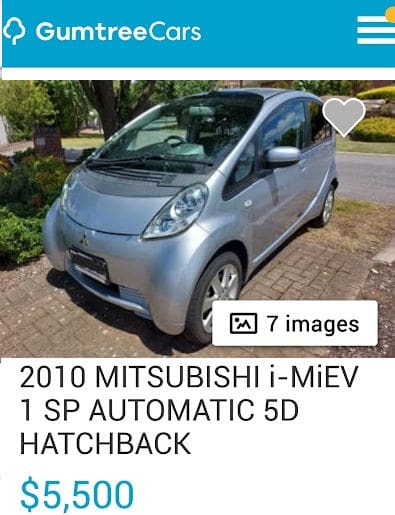
I didn’t ask how many actual inquiries there had been, but the nice lady took my first offer of $4,000. Dammit.
How Fast Does It Charge?
With the troglodytes and nervous nellies clutching their pearls about sub-600km range, I expect questions, including as to how fast it charges.
On a rapid DC public charger it’s about 25 minutes. I’m told that CHAdeMO is both the name of the fast charging plug and a play on words — Japanese for the ‘cup of tea’ you can drink while you wait.
At home it’ll charge at 12 to 14 kilometres per hour, when parked of course.
And yes, you read that right. A standard wall charger puts out 2kW, so that means I can pick up roughly 13.66km of range for each hour spent plugged in. We need a new three letter acronym, range per hour, kR/h perhaps?
Why I’ve Bought Another One
Honestly, $4,000 is the main reason I bought it. For that sum, I was expecting something to be fundamentally flawed, but the tyres are great, the air conditioning works, and it’s even got brand-new monogrammed floor mats. Unlike a converted classic Land Rover, it’s got ABS, stability control, electric windows, airbags and a heated seat; for about $96,000 less.
Like other cult classics, the iMiev is just endearing. They’re often low mileage because they’re not designed for long distances, and people just seem to look after them. We need more of that basic conservation. As a species we can’t expect to have nice things if we keep consuming at exponential rates.

This mind-boggling graphic puts things into perspective. Image credit: twitter.com/AukeHoekstra.
Why So Cheap?
In a word, hail. When you get close enough the roof looks like a golf ball (we have named this car Greg the Golf Ball… a white shark he is not).
So far I’ve only spent a couple of days driving around and haven’t had an opportunity to run all the tests I’d like.
However, like many EVs, the iMiev can be interrogated with an OBD2 connection and an app on your phone. So far, the onboard systems tell me the battery has a ‘state of health’ of between 57% and 61% — worn but certainly not a disaster for a 13.5-year-old battery.
At 63,000km you would expect a petrol-powered car to be in fine fettle. But I know first-hand as an engine machinist, it only takes one good episode of overheating to blow a gasket, rendering a cylinder head soft and useless. At 10 or 15 years old, cooling system corrosion can ruin an engine, exhaust or fuel tank too.
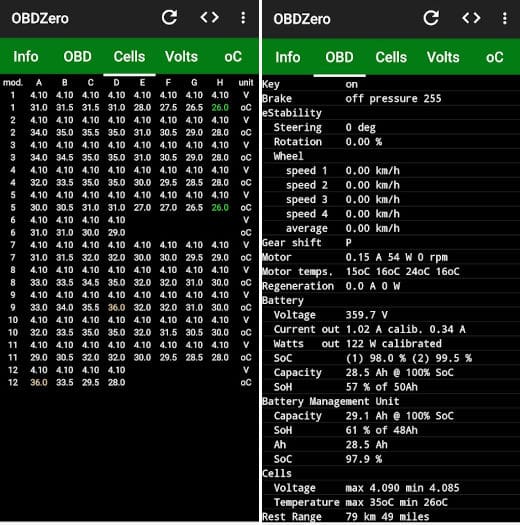
There’s oodles of information for nerds if you buy a cheap Bluetooth diagnostic module.
Won’t It Soon Be Worthless?
Not at all. As a work experience kid, I remember helping recondition the engine in a VK Commodore at just 120,000km. It was probably six or seven years old, but burning oil and worn out.
The last of Holden’s six-cylinder engines were rubbish, so working to better tolerances than the factory, we made it better than new, but I assure you it would never go twice as fast or use half the fuel.
While some dismiss EVs as a fad that will end up a liability or in landfill, we’re already seeing a secondary market emerging for new, improved batteries. For around $16,000, OZ Electric Vehicles will repack your iMiev and give it double the original range.
Your car becomes better than new — doubly so — for less than a third of the original purchase price.
Better still, OZ repurposes the old cells for less demanding applications such as off-grid house batteries.
Cheap EVs Are Out There
A quick search on Valentine’s Day produced this crop. I couldn’t believe there were so many iMiEVs available. In fact, these listings represent more than 2% of the whole Australian fleet. Come to think of it, I own 1% of them myself.
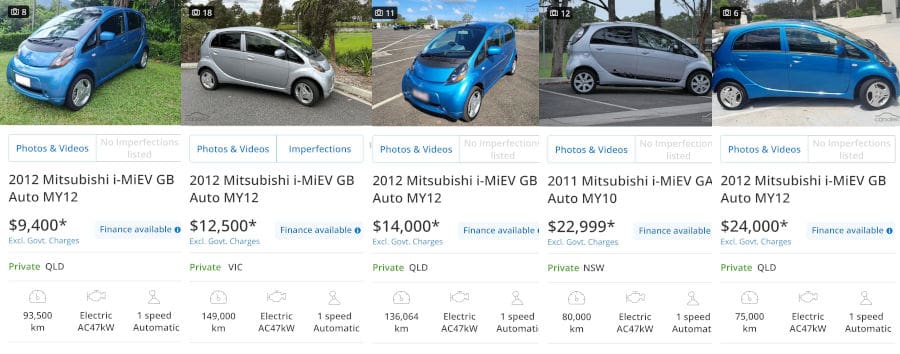
They’re available in black, white and red too. A couple of these even have new batteries fitted already.
I’ve Always Been A Small Car Advocate
Car collecting is a curse and a joy. I’ve lent Irene to my mum now, so it’s definitely joy that I’m spreading.
Fun fact: Kei cars are incredibly popular. Despite reduced tax incentives, they have often represented 30% to 40% of the Japanese domestic car market (where street parking is a regulated privilege). They’re narrow, upright, often boxy little vans, utes and sedans, normally powered with a 660cc two- or three-cylinder engine with an industry self-imposed power limit of 47kW.
In Australia, they’re just as useful, just as economical, and wildly underrated. No, you won’t get 800km on one charge, but the average commute in Australia is 15.6km. Forget about Ned Kelly and the bush, most Australians are in fact Ned Flanders in the suburbs — Greg or Irene will get you to the beach and back, with a school run and grocery run enroute.
It’s Not All Beer And Skittles
I would be lying if I said EV ownership was all fun and games. Next week I’ll put some context around what’s happening in this image. Stay tuned.
Footnotes
- High speeds sap range for EVs, especially those with poor aerodynamics. ↩

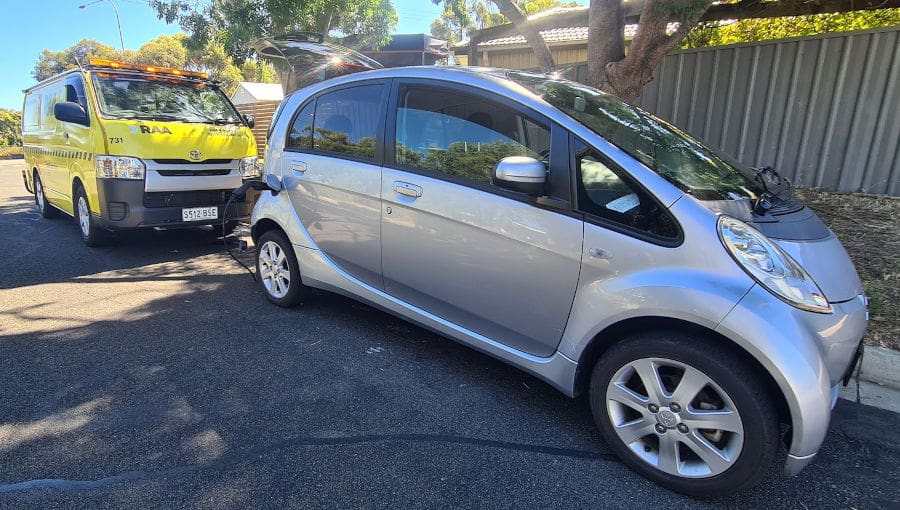
 RSS - Posts
RSS - Posts



Leadfoot! You should be able to get an Imiev to under 12kwh/100km for mixed driving. We drive to town & back (abt 45Kms) on less than 50%, & recharge with granny in about 3 hours. It uses about 6Kw for the fast country road trip with little regen braking compared to stop/start city drives.
I am interested in a BYD T3, but unfortunately BYD no longer imports them. I want a small camper.
In referencing an EV, the term should be Electronfoot!
I can still remember that car coming out for the first time, it was on display at the Solar Challenge Race finish in Victoria Square. My wife and I saw it as the perfect second car for us, as she works in the CBD, where I drive her and back home 5 days a week.
The put-off was the $64,0000 price tag! Who would have been so stupid to pay that?
A Honda Jazz or Hyundai Getz was and still is a much more sensible choice.
It seems that Australians need hugely massive cars, not because of what we need to carry, but because we are obese. There are a huge number of drivers who would struggle to get into an old Holden or Ford family sedan.
Now, what we are seeing, is what happened to the 32″ TV, the first price was in the thousands and quickly fell to the hundreds.
We are so far behind the rest of the world, where EV prices are about the same price as any other fueled car.
A comment on another post has the Toyota Corolla Cross at $38k. I’ve just paid $41k (+on-road) for an MG4. The fuel savings can take care of the difference in a year. Service interval is 2 years. And the BYD Dolphin is even closer in price? There is no substantial up front price penalty here, so after a year there’s comparative money rolling into the bank.
OK, it accelerates too easily, and hugs the road like a dream, but engage intelligent speed limit mode, and regen braking pulls you down to the posted limit the moment the on-board camera breasts each speed limit sign, with a mimic on the driver display. It sees speed limit signs better than I do, so I think it can save me the price difference in speeding fines alone.
Driving mostly at 100 on the highway, with aircon, I’m getting more like 280 km range than the cited 350 km WLTP, combined city/highway, but who cares. If that installer will just turn up on Wednesday with the Victrons, Fronius, and MPPTS, and the panels make it up onto the roof, they’ll be flamin’ free km. Fossil fume free too.
The economy and resource conservation of a 2nd hand EV is inspiring. Now if only there had been an EV ute, all prayers would be answered.
There are lots of people putting new, MUCH BIGGER batteries in these.
Might be an option??
I think the replacement batteries are the same size but they will have up to double the kWh compared to the original iMEV that came out 10+ years ago.
This is purely a city car so I don’t think the range is an issue. Like I wouldn’t get a Mazda 2 to drive between Sydney and Perth.
How come?
My Moke is OK for Darwin > Sydney.
¯\_(ツ)_/¯
Anyway, one shouldn’t neeed a car in the city. That’s just a big, fay mistake we’ve made in Australia (and USA).
You might be interested in the ANCAP crash tests of the iMIEV in 2010:
https://www-nrd.nhtsa.dot.gov/departments/esv/22nd//files/22ESV-000107.pdf
with the results published here:
https://s3.amazonaws.com/cdn.ancap.com.au/app/public/assets/326f9356629f10fbbe701b54f142e690f0358525/original.pdf?
It did reasonable well for a tiny vehicle!
If you ever want to upgrade them, here’s the fully charged show talking about an Aussie company doing this. Video is from this month.
https://youtu.be/oDuEr-cPl38?si=EkTwoT4aEQ_OOHbc
We bought our Imiev in 2012 when they stopped importing them. $25K on the road. Our poor car has 130K kms on the clock now. Sometimes it gets charged twice a day (town in the morning, home for lunch, & back to town! 3 hours gets the battery fairly full (abt 6 kw on the 240v/8A granny charger (). Our biggest issue is tyres. The rears are easy, but the fronts are miniscule (but do not try to catch me thru the windies! A commodore almost lost it one time…).
Tyres are the biggest issue with economy on an EV. My Kona had horrible Nexens originally: changed to Bridgestone Ecopia & lost 1Kw/100. Now have Continental EV6s on the front & regained 0.5Km/100. Quite impressed with the Contis.
On the Imiev, we runs what we can get. Currently some dreaded Oriental front tyre, but the rural potholes kill tyres (& rims). One front rim had been straightened 5 times, but now have a replacement set (Thanks Graham at SuziAuto). I feel the tyres are one of the reasons for the reduced range we experience. I buy front tyres in sets of 4 so I always have spares.
The only problem we have experienced on the Imiev was water in the A/C electronics, causing a HV error. Fixed myself, rotten job with the car on blocks. Dry out the electronics with a fan heater, until the AC pump s almost too hot to touch. Finally fixed by making a heavy gauge aluminium cover (original tin plate, 2 layers). The fix was to fit a surfboard breather valve (tapped into the Al replacement cover), which allow the moisture to transpire. (Watch where you fit the valves: they need to miss everything!) The surfboard valves use the same breathable material used in better rain jackets.
As far as space goes in the Imiev, I reckon I can fit more goods in the Imiev than would fit in the Kona. My sorties to the tip shop are legendary! The design is really roomy, for instance I fitted my Ego lawnmower & a 120L Wheelie bin in one load with other items!
A range test for the battery upgraded “Super” i-MiEV 200+ ks 🙂 https://www.youtube.com/watch?v=w2xGt-BDvDo
and https://www.facebook.com/groups/502783836944412
It seems you got an extraordinary deal. I just checked car sales.com.au, and there is only one second-hand i-MiEV available in NSW. It is a 2011 model with 80K on the clock for $23K.
$4K is on the high side of my budget for a vehicle. From 2000, I have driven nothing but second-hand Citroens. They are fabulous cars, mid-level luxury, reliable and get great fuel economy. I spent $17K on car purchases over that entire period.
My latest ride is a 2008 C5 HDi. It has full leather interior, all the mod cons (less a touch screen–I see that as a bonus). I splurged this time, because it was a great deal. It is the lowest km vehicle I have ever owned. (It had less than 80K on it when I bought it.) I plan to keep it at least ten years, perhaps more. It returns 5L/100km on the open road and has a cruising range above 1000km. It cost me $6000 plus around $1000 for an unanticipated gearbox repair. Still good value.
I like the idea of electric cars. Always have. I doubt whether I will live long enough for me to see one as value for money. You state,
“For around $16,000, OZ Electric Vehicles will repack your iMiev and give it double the original range.”
So, I can spend $17K on my I-MiEV and I still won’t be able to make it to Sydney on a single charge. My car cost less than half the cost of the upgrade, and I can make it to Sydney and back on less than half a tank of juice.
“the average commute in Australia is 15.6km”
I am old and fat now, but when I was young and fit, I rode a pushbike. I was mainly car-free from 1982 to 1999. (My daughter’s mother insisted that if you have a child you need a car. She was wrong about that, but I was in love.) I easily (and happily) did the average commute. My longest daily commute was around 50km return, and it didn’t save any time taking the car. I happily did that for over 5 years. I had a shower at work.
$1-2K will get you a very good new bike, $3-4K with an electric motor. That will be my next vehicle purchase.
Good points Bill,
Using existing cars is better value than just making new electric ones for the sake of it, but eBikes are a great idea too. If only the Nanny state would allow 1kW I think a lot of people would be more interested. 250w isn’t enough to climb hills really, especially if you have a cargo bike full of kids.
I do not think rationality reigns in the transportation decisions of a majority of Australians. For most trips a pushbike is ideal. And with more people riding pushbikes the more ideal they get.
Benefits for tackling global warming are just the tip of the iceberg. One of the biggest problems with cars is the amount of space they take up in overcrowded urban environments. The i-MiEV is a great improvement over the ubiquitous SUV. The former may even take up half as much space on the road and carpark than the latter. But it still takes up around five times as much space as a pushbike. Imagine the reduction in congestion if every able-bodied person in Australia traded in their motorcar for an eBike.
People who cycle regularly are fitter than are non-cyclists. I knew people who drove to the fitness club to do a half our on the stationary bike. That is kind of mad. I know people think pushbikes are unsafe. I haven’t looked it up, but the biggest danger to cyclists are automobiles. Even if it is not, I would wager that automobiles are the largest perceived risk.
Of course, there are no comparison in cost. A good bike with proper maintenance can last a lifetime, especially if it is not battery assisted. A solid serious pushbike can be had for $1000. But even if you lashed out and spent $3000, amortised over 30 years, we are talking much less than a cup of coffee per day. Maintenance and repairs are easy. And, for me, sailing past the petrol station, without never needing to stop there, was alone worth the effort.
Riding a pushbike was ALL benefit, for me, with ZERO sacrifice. The thought of riding in the rain is MUCH more unpleasant than the experience actually is. And even an i-MiEV is an expensive umbrella. Giving up a car for ten years allowed me to accumulate a 1000-bottle fine wine cellar. And I only invested less than half of the savings in the cellar. I am reaping the rewards of that decision today.
Out of characters, yet again. More later.
Well, true, but this forum receives posts mainly from people who prefer sitting down on soft cushions, and who either hate burners or hate EVs.
I grew up in Australia, and didn’t know any better, so I thought everyone in the world must need to get in and out of a car each all day. Then I discovered what it’s like to be free of babysitting a car when I lived in Barcelona for 5 years. It had about the same population as Perth, but is 1/42 the size of Perth. Yep, 42 times smaller. EVERYTHING in the city is within walking distance.
It took me about 6 months to work out where all this extra time, money, and sense of freedom was coming from.
Greetings Old Gregg!
Exactly. The two biggest objections to pushbike commuting I used to get back in the young and fit days was it was too dangerous and one would get wet in the rain.
The biggest perceived danger was motorcars.
Back then, a good new car was around $30,000. That is an expensive umbrella.
Typically my daily commute in Newcastle was around 10km each way. It took me 20-30 minutes door-to-door. It kept me fit. If you did not discount finding a car park and walking 5-10 minutes to the office, the bicycle was faster, especially in peak traffic.
According to NRMA calculations, car ownership costed around $5000 per year then, discounting the cost of the vehicle. If the car was new and financed, the cost, including the vehicle, was $10,000. That was 20% of my gross salary back then.
I was saw an academic paper that added the amount of time required to earn the money to cover car costs into commute times back in the 1990s. Their calculations estimated in a major city in the UK at the time, a car, with the costs included, would make under 20km/h. I suspect, in Sydney today, the speed would be considerably less. I know people who commute 20km each way for whom the drive takes the best part of an hour in peak traffic.
This seems like madness to me.
The proverbial quarter-acre block plays a role, but the main reason that the area of Perth is so much larger than Barcelona is that it must accomodate a car for every man, woman and child living there.
A daily commute requires the area of TWO car parking spaces, one at each end. I am sure someone has calculated how much space is dedicated to motorcars in large cities. I could look it up, but I do not need convincing.
This is my biggest objection to electric cars. Whether they make a significant impact to solving the global climate change problem is moot. However, they do nothing to solve the real problems of mass car ownership.
Freedom is hard to measure, but a significant variable.
Like quite a few comments here, most are about costs, and even as a young lad, I started to wonder if it’s all worth it! When I started working in 1972, I took home $20 per week, the dole was $16! I was earning just 10 cents per hour!
Now, I automatically deduct what I can get, doing nothing from what I get working, you don’t need a car, you might not need a smartphone or broadband. When you think about it, we spend most of our money to earn that money! It’s a Catch-22 thing.
I can not understand why people pay stupid prices for EVs or any car. It’s like buying a Rolex to tell you the time, while a $5 watch will do the same.
Today’s cars are very reliable and a $5000 car will do the same job as a brand-new $50,000 one. We waste money to give us the impression that we save, and that is what EVs are doing now. Home batteries are not cost-effective, so why are EVs?
I ride a e-bike and have an i-miev. Here in Sydney it can be too hot to cycle. Plus there are a lot of very poor drivers here. So it can be dangerous. The i-miev will find somewhere to park because a lot of drivers park in such a manner there is a small space left. It doesn’t matter the weather in the i-miev. Also I can recharge at work. That makes up for the bridge toll.
Strange that you criticise the drivers, here in Adelaide, on ABC radio a Dutch lady who migrated to Adelaide recently said she stopped riding, not because of the car drivers, but the other cyclists! The Lycra brigade was the problem.
We need more tiny city EVs, that don’t cost a bomb to buy!
Now! I have to ask, can I build my cargo bike? How would anyone know that I have over 1000 watts of power? I can see that all mobility machines will need to be registered at some stage. Building one isn’t hard as ALDI do a fold-away electric bike that isn’t great but a great starting platform.
Eric if you hunt up a forum called endless sphere they’re all about eBikes.
European standards say you shouldn’t have more than 250w of assistance but I think the main thing is not to exceed 25km/h… and keep pedalling… you’ll not attract attention that way.
Hello Anthony,
I’m interested in Purchasing a new Mitsubishi Apollo Cross??? Mid size PHEV SUV as I have previously been a Panel repair car cleaner for six years. I’m lucky enough to have developed arthritis in my spine.
I’m six Foot tall and over the six years of cleaning 25 cars a week, this was by far the most comfortable car to enter and exit. ($51.5K which I’m not overly impressed about spending)
Started reading your forum to which I’m responding as I have a 2003 4×2 Holden rodeo cab chassis ute which is still quite comfortable (145,000Ks), and not a real problem to enter and exit.
Never considered a EV conversion, not sure why!
Cars body is in excellent shape, motors reasonably good (That will be gone any way), clutch is HORRIBLE ($1,800 to replace) and that may be why the gear box seam a bit average??? (Conversion, Food for thought)
Endless Sphere, I recently fitted a geared front hub motor to my 700c flat bar road racer, long story short, the 250 watt hub motor did struggle on long slight inclines.
Took it back to the bike shop, replaced the 250 watt controller with a 350 watt controller, problem 95% fixed. Still only dose 26-28kph top speed. (So its still legal)
My research suggested if I’m going faster than 25kp/h, I simply need to be pedaling!
I asked about a larger controller and was told that a 500 watt controller may burn out the hub motor.
Later my research found that 500 watt controller would have probably been OK.
Hope this is not to far off topic.
Regards David Edwards
PS. Thinking about building a Fat wheeled mountain bike with two 250 watt hub motors and two 350 watt controllers, still legal!
Hi Dave,
Sounds like you’re having some fun.
Converting cars isn’t cheap unless you can DIY most of it. I think an off the shelf Series Landrover from Jaunt is $150,000 but they are a lovely job with everything new.
If you look up https://openinverter.org/wiki/Main_Page you’ll find there’s a lot of factory gear that’s been “hacked” to make conversions work. Alternatively there’s dedicated motors and controllers available but they are low volume production and not cheap.
Looks like you’ve found what I think is a real problem with e-bikes… 250watts isn’t enough. If we want people to surrender cars then they need to be able to climb hills without standing on the pedals.
We follow european rules so a bike with a throttle only has 200w assistance, a pedalec can only have 250w and no assistance above 25km/h.
I’ve ridden an e-bike which according to it’s on screen display puts out 800w and that’s pretty practical for turning an hour long uphill journey into the 45 minutes it would take to do it the other way. You still don’t want bicycles doing 45km/h though. By the time you’ve improved the brakes & tyres enough you’re really looking at an electric motorcyle which needs a licence & a proper helmet.
I should ask what’s your favourite cleaning gear?
I used to want an EV but the more I read about them the more I wouldn’t now touch one with a barge pole.
People are finding out that they are essentially worthless in terms of depreciation, increasing insurance costs and the recharging impracticalities unless you have your own home and recharging system. Not to mention the serious safety risks if the cells are damaged in an accident or catch fire through some defect.
Great for retirees to pootle to the local Bunnings on a Sunday and for practically no one else. You got both cheap because not many want them and essentially they will just become expensive landfill paperweights with zero resale value.
Hi Reg,
Did you actually read the article? “essentially worthless expensive landfill paperweights” seems to be a salad of 2GB buzzwords. I’m afraid you’re taken by the Fear, Uncertainty and Doubt (FUD) more than is reasonably needed.
I own a Mitsubishi Outlander PHEV and that commands an $8000 premium over the standard petrol version last I checked the second hand market. Purchased ex factory lease for $30k it simply didn’t depreciate for 3 years. My iMiev was cheap because of hail damage. As you can see from the adverts in the article, not many other small cars command a $9000 as a well used car.
In terms of recharging system, there’s already millions of them all over the country, they’re several orders of magnitude more more common than petrol stations.
https://www.solarquotes.com.au/blog/ev-charging-power-outlet/
EVs are 25 times less likely to catch fire.
https://support.solarquotes.com.au/hc/en-us/articles/6041404837135-I-Want-To-Charge-An-EV-In-My-Garage-Can-It-Catch-Fire
We can help you save a good deal of money on motoring and energy but you’ll need to be willing to help yourself by reading.
Don’t forget the Miev Minicab! Very practical and similar range to the Imiev if you get a late model one. We charge at home off the solar during the day so we forgo 8c KWh.
Out of about 150,000 EVs in Australia, a total of two have caught fire in accidents. One hit a tree at 160km/h and the other, doing 111 km/h ran over the tail shaft of a truck that had dropped on the road.
I’ve owned an iMiev for 4 years now and I would never go back to a petrol car. I just love it, so I called her Little Toot and even wrote a poem about her. She is just magic to drive and has cost me nothing to run so far except the electricity off the solar panels on my roof. My husband was over 6 foot tall and a big man. He still had heaps of head room and plenty of comfortable space to sit. It is more convenient than a conventional car for stacking with groceries and when the seats are down the area in the back is huge. I have fitted in a washing machine and large bird cages on wheels for parrots. It is the most amazing vehicle I’ve ever owned and it only cost me $8,000 4 years ago. I am hoping to be able to get a larger battery one day but as far as doing local shopping and going to work it can’t be beaten. So happy to see this little work horse get a good review. Judy Renner, Tocumwal
” I used to want a petrol car but the more I read about them the more I wouldn’t now touch one with a barge pole.
People are finding out that they are essentially worthless in terms of depreciation, increasing insurance costs and the fuel cost variation impracticalities unless you have your own home and refinery system. Not to mention the serious safety risks if the fuel manifolds are damaged in an accident or catch fire through some defect.
Great for retirees to pootle to the local Bunnings on a Sunday and for practically no one else. You got both cheap because not many want them and essentially they are just expensive landfill paperweights with zero resale value”.
I’ll wave to you then as I pass by in my warm and toasty combustion engine when you go to try to use your heater in winter and range-strand yourself miles from anywhere and even more miles from a working charge point 🙂
Just because solar is practical on your roof doesn’t mean it can be relied on in a vehicle. The difference is that if the sun doesn’t shine on your roof most still have a backup mains power supply to fall back on and you sit in a chair until peer resumes. No easy Plan B on the open road.
A lot of UK owners and others are rapidly coming to the conclusion that EVs now will only ever be a niche product in very limited urban environments and many are regretting their early adopter status finding their shiny new toys don’t work that well in cold weather and even more recently as their insurance premiums going through the roof.
Hi Reg,
I think you’ll find the EV owners in snowy England are perfectly happy to have prewarmed cars with clear windscreens, run quietly and efficiently from mains power, using WiFi control, without having to leave the house. Still there’s precious little snow in Australia so I guess that’s a moot point.
As for plan B on the open highway, I’ve just experienced the RAA emergency EV charging service and it’s great. There’s another post coming up soon explaining that.
As a sidebar, there’s a few million more power points in Australia than there are petrol stations. I’ll bet there’s even a few at your house 😉
In the beginning petrol cars were a huge pain, to get fuel into them was a very long process, you needed to go to your Chemist shop and order this very dangerous substance. No one knew anything about it.
It took years before fueling took off. Electric car development is moving much faster, when you see that the petrol engine hasn’t really changed in how many years? It is still regarded as being very inefficient.
Eric it’s fascinating,
People don’t realise how fuel used to be supplied, to chemists where you also got dry cell batteries for your ignition system. Then later to blacksmiths workshops as they progressed into becoming mechanics.
Fuel companies would put a couple of four gallon tins in a wooden crate and then freight them via rail, & distribute them by horse drawn wagon. In modern terms it was akin to buying spring water from the shop in a 36 litre carton, then filling your car from a jerry can. Mind you there would probably be a litre or three of motor oil involved as well.
This building is clad with 4 gallon petrol tins:
https://ih1.redbubble.net/image.790156808.2068/flat,1000×1000,075,f.jpg
I was offered $25K for my 2020 14,000 km MG ZS EV Mk1 with four years of remaining warranty as a trade in – so I kept it. The Mk1 is known for its reliability and has a rated range of 265 km. There are bargain EVs out there particularly as EVs wear at a much lower rate than internal combustion cars. You might pay around $25K for a petrol MG ZS but you can buy a three-year-old EV version for around the same money if you buy privately. If the MG4, Dolphin and Ora depreciate at the same rate the used EV car buyer will be spoilt for choice in three years. And some of the high-mileage more expensive EVs will also be good buys.
Anthony, I love solar power but your story with its justifications/rationlisations has more holes than Swiss cheese (do you drive at night?–if not, factor in battery costs; funny how you put a new battery in an EV and its suddendly a new car, but a similarly aged petrol car is just over the hill–you do realise you can buy a lot of engine for $16k; etc; etc; etc). And calling people names doesn’t make it any more rational.
Hi Gary,
I offered both worst case peak electricity rates and 8 cent solar feed in forgone… which incidentally you can get overnight on EV charging tariffs.
I assure you I have worked in an engine machine shop, one time national engine reconditioner of the year in fact. Modern ICE engines don’t wear out like they used to, but overhauling them is very expensive because they have twice as many valves to grind, much fussier surface finishes and finer tolerances to achieve and many more hours in cleaning and assembly because there’s hundreds of moving parts.
In a nutshell we simply don’t repair engines much anymore because $16,000 might get you an engine overhaul, but it doesn’t include the equally complex automatic transmission.
My former workplace specialises in vintage restoration and performance work now, where people will drop $50,000 on an engine for a car worth half as much and they’ll be incredibly pleased if it goes twice as fast using twice as much fuel at the drags.
The labour content and technical requirements for a battery replacement is an order of magnitude simpler, so is the car you put it in, which just means it’ll last longer.
My Ford Model T is a hundred years old, it has no water pump, fuel pump or oil pump. It’s so mechanically simple; but it still has more moving parts than an EV.
Hi All, my 10c.
I had an IMiev for 4 months. It cost 11k (Perth, WA) and was a complete impulse buy. I charged it for free at my local library but the range was the killer.
I don’t know the charging specifics, but a library charge would take 3 hours and at home overnight was about 7 hours.
The indicated “full” range was around 85km but this was NEVER realistic. Town driving to work is 26km with a mixture of 0-50 – 70km/h driving and the odd up and down small hills. This is my gripe – I barely made it there and back most days and it was definitely touch and go if I took a small 4km detour on the way home – so realistic range was about 56km. It went into “limp” mode twice at an embarrassing 10/15km/h. The sad thing is I was soooo keen to use it. I drove like a “nanny” to maintain range and it just about made it to work and back. The range was even worse if it was colder (down to 3/4/5 deg.) overnight. I tried, but it was just too stressful in the end even though I was driving for free! The range just meant it was a local shopper and that was it – pretty useless when Perth city is 25km away and there is NO WAY I would take it on the freeway as the range “fell like a stone.”
An interesting car but seriously flawed in the real world.
Needless to say, I sold it for a $500 loss and breathed a sigh of relief when it drove off!
Hi James,
Thanks for the honest detail, you’ll love the next update. Just out of curiosity, you’d have been laughing with a new battery though?
Yes, like you said “Impulse Buy”! No thought went into it!
When I looked at one, I saw 8.5 km of flat road to the city, 10.0 km to some and shopping. That would work! The price tag at the time didn’t.
NEVER, EVER do or buy anything on impulse.
Mark,
That video is 2hr33min long. I doubt many of us have that much time to spare.
Lots of interesting (& mostly respectful) discussion here….On a slightly different topic Anthony, do you know whether the Chademo charging infrastructure in the imiev has the potential for V2X of any type, usun* the battery as backup storage or a power supply? I gather once removed, the old battery could be used as home storage, is that correct, off setting some of the cost of replacement?
Cheers, Pete
Modern ICE engines don’t wear out like they used to, but overhauling them is very expensive because they have twice as many valves to grind, much fussier surface finishes and finer tolerances to achieve and many more hours in cleaning and assembly because there’s hundreds of moving parts.
You’re bang on Tahsin,
There’s often more consumable parts like timing chains, guides & tensioners which are unique to brands and specific models.
Plus single use parts like torque to yield bolts & sintered connecting rods that are impossible to resize.
Electronic sensors, wiring looms, plastic manifolds & cooling system parts all fail with age & heat stress.
And specific tooling to machine & assemble particular engines makes things even more expensive.
Long gone are the days of a quick hone & re-ring along with a set of bearing shells.
Thankfully the days of cars issuing blue oil smoke at the traffic lights are gone too.